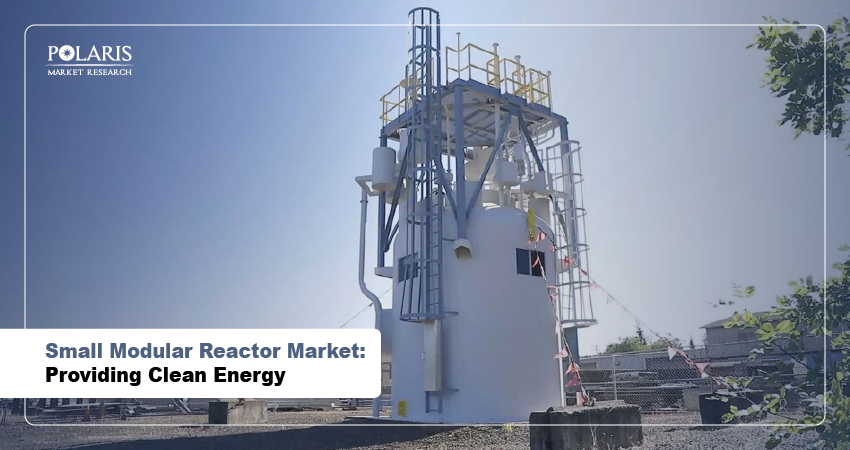Small Modular Reactor Market: Providing Clean Energy

The world is increasingly seeking energy sources that are clean and reliable. Countries are increasingly moving towards nuclear power for their energy needs. Small modular reactors have become popular as a highly promising innovation in the nuclear power landscape. The flexible and scalable nature of these reactors is changing the way the deployment of nuclear energy is done in the modern world.
But what is it about the small modular reactor market that’s driving its increased demand across the globe? Stick with us as we explain to you the fundamentals of these reactors and what’s fueling their rising usage globally.
Small Modular Reactor: Overview
A small modular reactor is a nuclear fission reactor. The reactor is typically capable of producing up to 300 megawatts (MW) of electric power per unit. This is a fraction of what’s generated by nuclear plants. However, the modular architecture means several reactors can work together at a single site. So, it is possible to scale output as required.
The key feature of small modular reactors is their standardized design. Traditional nuclear reactors need to be built from scratch at the site. Their completion also takes several years. Small modular reactors differ from conventional reactors in that their manufacturing can be done in controlled factory settings. The modular approach reduces construction time and helps keep quality consistent.
Small modular reactors are also highly flexible. They can function as standalone units. They can also be combined in groups to meet higher energy needs. This makes them suitable for various uses, including supplying energy to remote locations.
Key Market Metrics
Our analysis reveals the market for small modular reactors to witness continued growth. The small modular reactor market stood at USD 5.94 billion in 2024. It is expected to account for a CAGR of 2.97% between 2025 and 2034.
Types of Small Modular Reactors
Light Water Reactors (LWRs)
Light weight reactors are the most established types of modular reactors. They make use of ordinary water as both a coolant and a neutron moderator. This ensures familiarity for both regulators and operators. Light water reactors carry advanced passive safety systems. As such, the reactor can automatically shut down and cool itself with the use of gravity and natural convection. The standardized construction and use of mature fuel technology in these reactors are driving their increased deployment across the globe. LWRs are suitable for grid-connected power generation and urban energy needs. They are also used for hybrid integration with renewables from the renewable energy market.
High-Temperature Gas-Cooled Reactors (HTGRs)
The reactors represent a new class of small modular reactors. They have high thermal efficiency and are operationally safe. HTGRs make use of helium gas as a coolant and graphite as a neutron moderator. The operating temperatures of these reactors can go up to 900°C, which is way more than that of conventional reactors. This high-temperature capability allows for efficient production of electricity. It also generates industrial-grade heat for applications such as hydrogen production and desalination. As helium is an inert gas, the risk of corrosion or phase change is reduced here.
Molten Salt Reactors (MSRs)
This design of this reactor type from the small modular reactor market is highly innovative. These reactors make use of a molten salt mixture that acts as both a coolant and a solvent for the nuclear fuel itself. This configuration makes it possible for the reactor to operate at low pressure and be thermally efficient. Another notable thing about this reactor is that it uses alternative fuels such as thorium or recycled nuclear waste. This allows for a sustainable and closed fuel cycle. MSRs also have a self-regulating safety mechanism. Here, the overheating of the reactor results in the expansion of the molten salt. This slows down the reaction rate.
Uses of Small Modular Reactors
Powering Remote and Off-Grid Areas
Traditional energy infrastructure in remote locations may not be economically feasible. There may be challenges associated with logistics. Isolated areas often depend on imported fossil fuels. Importing fossil fuels may have high costs and be vulnerable to supply chain disruptions. Small modular reactors offer a self-contained power source whose components can be assembled in factories and installed on-site. The refueling intervals of these reactors are long, taking away the requirement for continuous fuel deliveries.
Industrial and Process Heat Supply
Industrial sectors rely on fossil fuels for process heat. The use of fossil fuels contributes to global carbon emissions. Small modular reactors are capable of providing a clean source of high-temperature heat. As such, they can directly replace coal or natural gas in these energy-intensive industries. The use of small modular reactors in industries also improves energy security by enabling combined heat and power systems, which deliver both electricity and process steam. This cogeneration approach improves thermal stability and significantly lowers overall carbon intensity.
Hydrogen Production
Small modular reactors are being integrated into hydrogen production systems from the hydrogen generation market. The traditional method of generating carbon involves steam methane reforming and takes high amounts of carbon. In contrast, small modular reactors can produce the high-grade heat and electricity needed for water electrolysis without the emissions of greenhouse gases. Some reactors can operate at extremely high temperatures. As such, they can support thermochemical hydrogen production methods, which are more efficient than traditional electrolysis.
Conclusion
Small modular reactors are an innovative solution that has the potential to change how the world generates and consumes power. Several nations worldwide have made commitments towards a Net Zero target for carbon emissions. As such, these reactors are becoming a viable option to provide clean energy. The small modular reactor market is witnessing design innovations and strategic partnerships to offer more advanced solutions.

